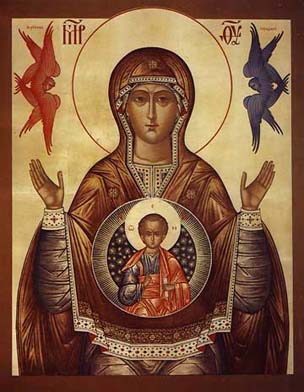
The Icon of the Mother of God, named the "Sign" ("Znamenie")
Commemorated on November 27
The Icon of the
Mother of God, named the "Sign" ("Znamenie"), images
the Most Holy Mother of God seated and with prayerfully uplifted hands; at Her
bosom, against the background of a circular shield (or sphere) – in blessing is
the Divine Infant – the Saviour-Emmanuel. Such like depiction of the Mother of
God is regarded as among the very first of Her iconographic images. In the
mausoleum of Saint Agnes at Rome is a depiction of the Mother of God with hands
outstretched in prayer with the Infant-Christ sitting upon Her knees. This
depiction is ascribed to the IV Century. Moreover, there is known an ancient
Byzantine image of the Mother of God "Nikopea" from the VI Century,
where the Most Holy Mother of God is depicted sitting upon a throne and holding
with both hands before Her an oval shield with the image of the
Saviour-Emmanuel. Icons of the Mother of God, known under the name
"Znamenie-Sign", appeared in Rus' during the XI-XII Centuries, and
were called such after a miraculous "Sign" from the Novgorod Icon,
which occurred in the year 1170.
In that year the
allied forces of Russian appanage princes, headed by a son of the Suzdal'
prince Andrei Bogoliubsky, marched to beneathe the very walls of Great
Novgorod. For the Novgorod people the only hope remaining was in the help of
God. Day and night they prayed, beseeching the Lord not to forsake them. On the
third night the Novgorod bishop Ilia heard a wondrous voice, commanding to be
taken out from the church of the Saviour–Transfiguration on Il'ina street the
image of the Most Holy Mother of God, and to carry it about on the city walls.
When they carried about the icon – the enemy let loose at the church
procession an hail of arrows, and one of them pierced the iconographic countenance
of the Mother of God. From Her eyes trickled tears, and the icon turned its
face towards the city. After such a Divine Sign there suddenly fell upon the
enemy an inexpressible terror, they began to strike at one another, and taking
encouragement from the Lord the Novgorodians fearlessly gave battle and gained
the victory.

In remembrance of the
miraculous intercession of the Queen of Heaven, archbishop Ilia there upon
established a feast day in honour of the Znamenie-Sign of the Mother of God,
which down through the present all the Russian Church celebrates. The Athos
priestmonk Pakhomios the Logothete, present at the festal celebration to the
Icon in Russia, wrote two canons for this feast. On certain of the Novgorod
Icons of the Znamenie-Sign, besides the Mother of God with the Praeternal
Divine-Infant, there were depicted the miraculous occurrences of the year 1170.
For 186 years afterwards, the wonderworking icon remained situated in the
self same Saviour-Transfiguration church on Il'ina street. But in 1356 there was
constructed for it in Novgorod a temple in honour of the Znamenie-Sign of the
Most Holy Mother of God, serving as cathedral for the Znamenie-Sign monastery.
Numerous copies of
the Znamenie-Sign Icon are known of throughout all Russia. Many of them
subsequently also were glorified by miracles in their local churches, and were
then named for the place of the appearance of the miracle. Such like copies of
the Znamenie-Sign Icon are the icons of Dionysievo-Glushitsk, Abalatsk, Kursk,
the Seraphimo-Ponetaevsk and others.
© 1996-2001 by translator Fr. S. Janos.